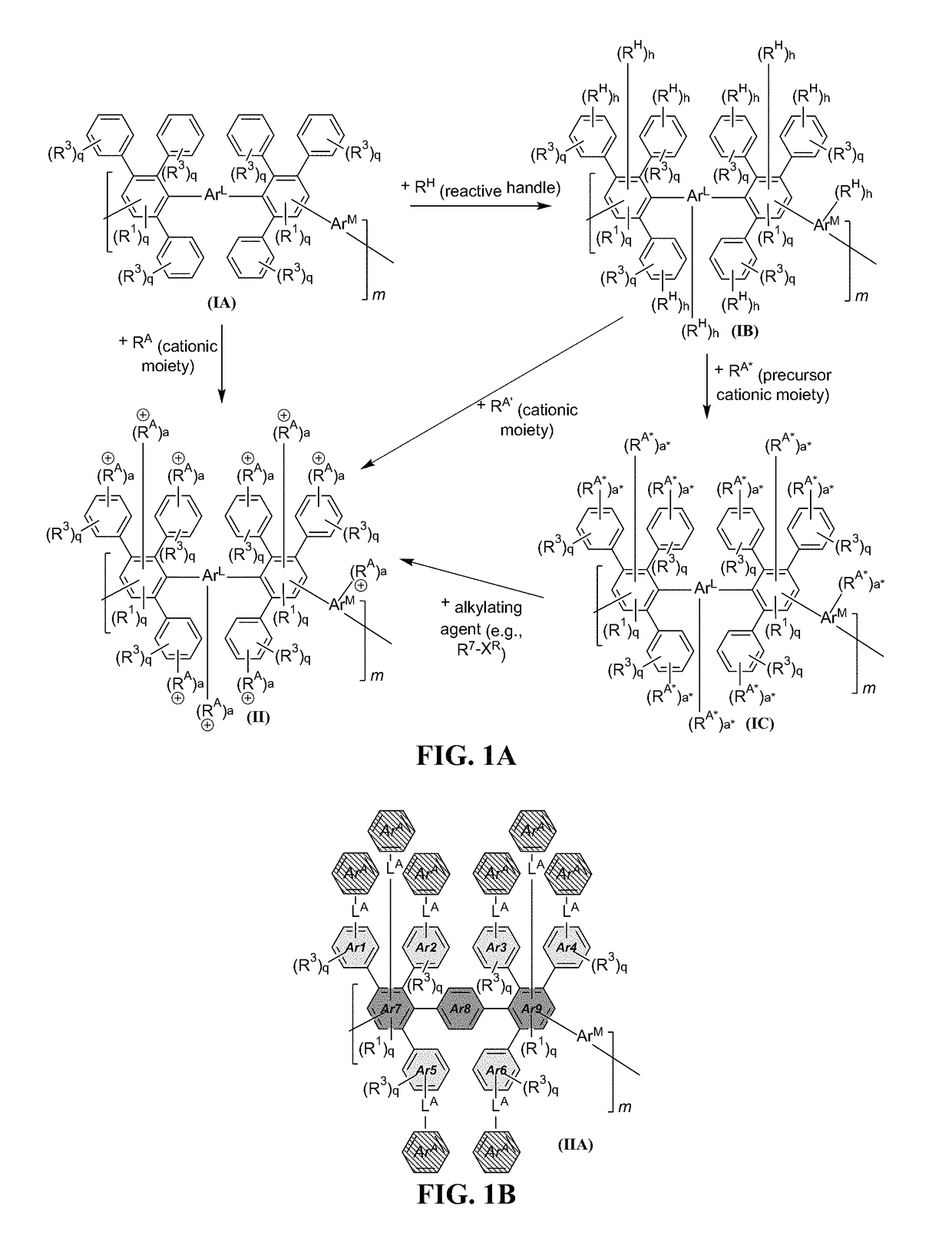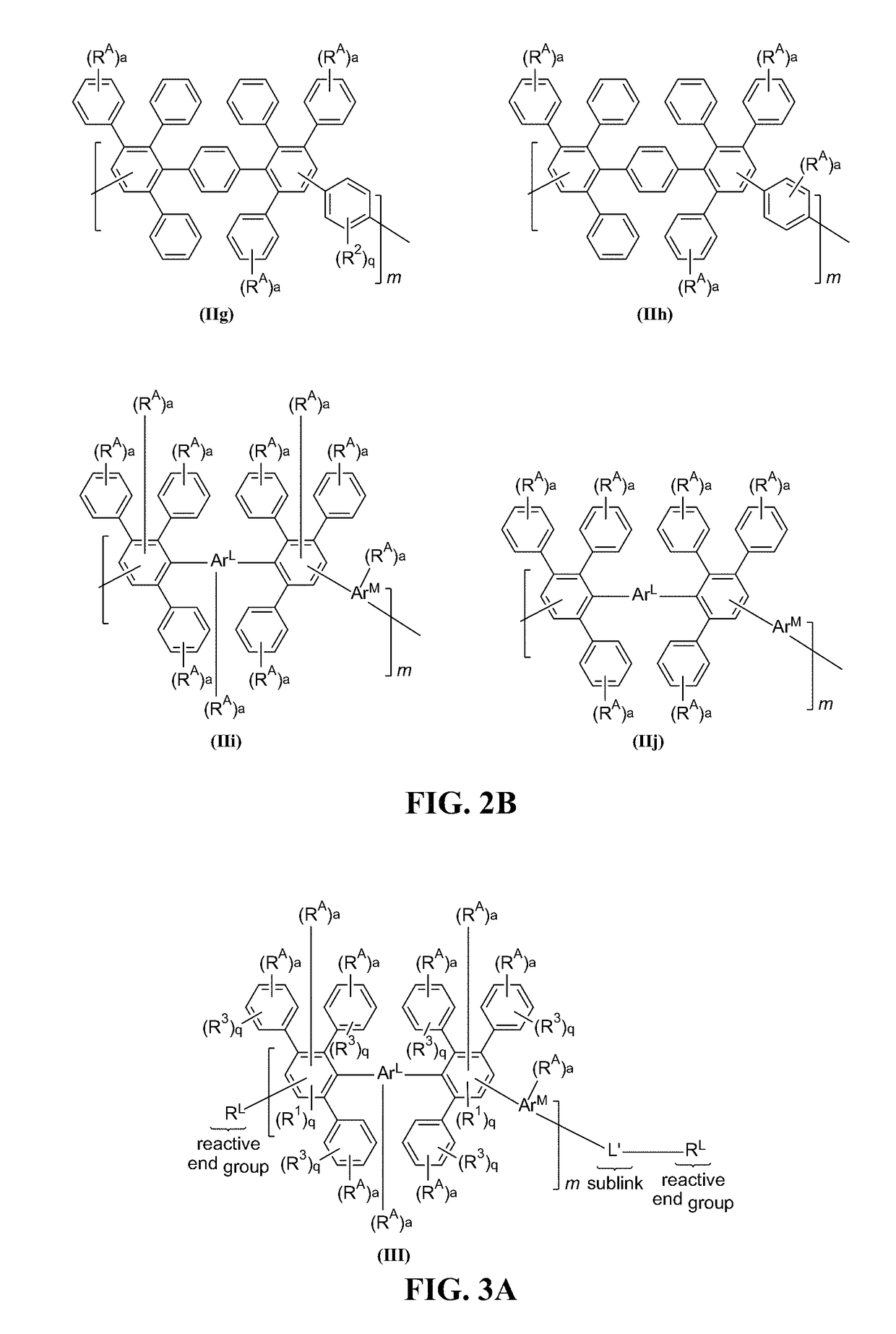Poly(phenylene)-based anion exchange polymers and methods thereof
- Summary
- Abstract
- Description
- Claims
- Application Information
AI Technical Summary
Benefits of technology
Problems solved by technology
Method used
Image
Examples
example 1
hange Polymer Electrolytes
[0259]Ion exchange polymer electrolytes and their dispersion in liquid medium are one aspect of fuel cells and other electrochemical applications. In fuel cells, electrochemical reactions occur either in acidic or alkaline media. In acidic environments, proton exchange membranes offer the required combination of adequate longevity and good conductivity at relatively low temperatures (e.g., of from about 25° C. to about 100° C.). Whereas fuel cells and electrolytes employ proton exchange membranes, alkaline fuel cells require anion-conducting polymer electrolytes. In alkaline environments, the efficiency of the oxygen reduction reaction is much higher than in acidic conditions, which allows the use of low-cost, abundant electro-catalysts as opposed to precious metal catalysts.
[0260]Traditionally, alkaline fuel cells use an aqueous solution of potassium hydroxide as the electrolyte, with typical concentrations of about 30%. A major operating constraint is the...
example 2
Having Carbonyl-Containing Linkers
[0286]The anion exchange polymers can include any useful linker, which can be installed in any useful manner. For instance, FIG. 7 shows an exemplary schematic that can be described generically as follows. First, the initial DAPP structure can be reacted to provide a reactive DAPP, which has one or more reactive handles and a linker including —C(O)—. The initial DAPP structure can be any described herein (e.g., having a structure of formula (I) or (IA)). Then, a precursor cationic moiety can be installed, and an alkylation reaction can be performed to form the cationic moiety. Finally, an optional anion exchange reaction can be performed to provide an anionic moiety B. As can be seen, this scheme allows an aryl group and a cationic functionality to be installed in a step-wise manner. For instance, a first step can include use of a reactive handle having an ArA aryl group, and a second step can include use of a precursor cationic moiety to install th...
example 3
Having Sulfonyl-Containing Linkers
[0291]In another instance, the ArA aryl group and the RA1 cationic functionality (or the ArA aryl group and a precursor cationic functionality RA1*) is installed at the same time. Furthermore, the linker can include any useful functional group, such as a sulfonyl (—S(O)2—) or a sulfoneamide (—S(O)2—NRL3— or —NRL3—S(O)2—, in which RL3 is any useful moiety group). FIG. 8 provides an exemplary synthetic scheme including such linkers.
[0292]As seen in FIG. 8, a substitution reaction is performed in the presence of an initial DAPP and a reagent RH—X (here, ClSO3H) to provide a reactive DAPP. The initial DAPP can be any described herein (e.g., having a structure of formula (I) or (IA)). Furthermore, RH—X can be chosen to include a linker portion (here, the —S(O)2— portion of a sulfonamide linker), as well as a halide that is reactive.
[0293]Next, the reactive DAPP is reacted with a precursor cationic moiety (here, N-(4-aminophenyl)-1,1,3,3,-tetramethylguani...
PUM
| Property | Measurement | Unit |
|---|---|---|
| Time | aaaaa | aaaaa |
| Composition | aaaaa | aaaaa |
| Structure | aaaaa | aaaaa |
Abstract
Description
Claims
Application Information
 Login to View More
Login to View More - R&D
- Intellectual Property
- Life Sciences
- Materials
- Tech Scout
- Unparalleled Data Quality
- Higher Quality Content
- 60% Fewer Hallucinations
Browse by: Latest US Patents, China's latest patents, Technical Efficacy Thesaurus, Application Domain, Technology Topic, Popular Technical Reports.
© 2025 PatSnap. All rights reserved.Legal|Privacy policy|Modern Slavery Act Transparency Statement|Sitemap|About US| Contact US: help@patsnap.com



